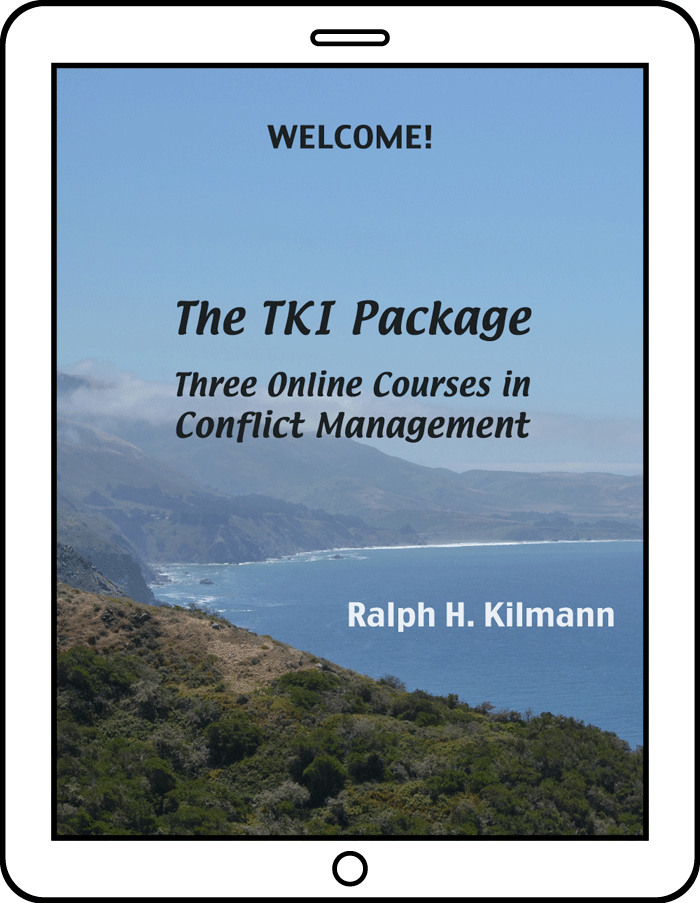
How to blend our
TKI courses with
live discussions
The members of the same work group (whether a department, task force, project group, cross-functional team, or process improvement team) will gain extra benefits from taking our series of online courses AS A GROUP. Rather than members of an organization taking our online courses separately and thus independently, learning key principles and practices with your workplace colleagues will not only enhance what every member learns from our online courses, but will also make it much easier to apply what is learned back on the job—where it counts.
Basically, when all group members (1) learn the same language and the same concepts, (2) review the same assessment tools and their personalized results, (3) analyze and discuss the same business cases, and (4) follow the same guidelines for effective behavior—BECAUSE all these principles are fully shared in the group, they are more likely to be put into practice when challenging problems and conflicts appear in the workplace.
On this page, I outline how a work group can take full advantage of all the valuable materials in The TKI Package in Conflict Management, which includes three online courses and two TKI assessments.
The unnumbered paragraphs describe what members are asked to do on their own, such as watch the course videos, take assessment tools, or complete work sheets in their course manual.
The numbered paragraphs then provide the detailed steps for learning the material through face-to-face or virtual group meetings.
Depending on the unique circumstances and needs of each group, this process for blended learning can be adjusted or expanded. Nevertheless, the combination of unnumbered and numbered paragraphs serves as an effective framework for enabling work groups to acquire the most useful knowledge and skills from our online courses:
Click to Read the
Detailed Steps for
Blended Learning
1. BASIC Training in Conflict Management
2. GROUP Training in Conflict Management
3. ADVANCED Training in Conflict Management
Defining a Work Group
Many times I’ve been asked: “What (or who) defines the membership of a work group?”
While organizations often assign people to a work unit (whether full-time or part-time assignments), the key question is: “Whom do you interact with on a daily basis?” Often times, it’s worthwhile to include people who informally participate in the group’s meetings, even if they are not “officially” assigned to the team. Moreover, there are increasing instances of virtual teams that interact mostly or entirely via online platforms (such as Zoom, Skype, or GoToMeeting).
But here is the really challenging question that’s best to address up front: When should the immediate supervisor, manager, or “boss” be included in the group’s learning process?
When the health of the culture is in doubt, I suggest that only peer groups participate in the discussions for the three courses in The TKI Package. Why? For effective learning to be achieved, it is imperative that every member feels safe to voice his true opinions and feelings during all group discussions. Otherwise, the leader might wind up doing most of the talking, while other members (to protect themselves from either real or imagined repercussions) might keep their views to themselves. Such withholding of participation, and thus withholding of different perspectives, would severely limit the potential benefits of discussing these online courses as a group.
The safest approach, therefore, is to use peer groups at the start: Non-supervisory members meet in their peer groups, just as their supervisors meet in their relevant peer groups. And the department heads then also meet in their peer groups, and so on, all the way up the management hierarchy. (Perhaps only the senior management team would necessarily meet in a non-peer arrangement by including the senior vice president or president of the business unit or whole organization.)
Occasionally, the “boss” of the group will be able to effectively guide his or her direct reports through our online courses (including all group discussions) in a candid and forthright manner. Most times, however, an expert consultant, trainer, or facilitator will be in the best position to ensure that the work group gains the most knowledge and skills from discussing our online courses. In the end, it’s up to the “powers-that-be” whether the immediate boss or an expert facilitator guides members through the learning process. Hopefully, such a far-reaching decision will be based on an accurate assessment of the culture of the group and the skills of its leader.
NOTE: During some of the online courses, I suggest when it’s a good time to take a ten or fifteen-minute break from my presentations and the group discussions. But please feel free to either skip or add breaks, depending on what works best for the learning process. And during the group activities outlined below, I also suggest the typical amount of time that might be necessary for each group discussion. But please adjust these meeting times to best suit the group’s needs—which will partly depend on the size of the group and the depth of the discussion.
THE DETAILED STEPS
1. BASIC Training in Conflict Management
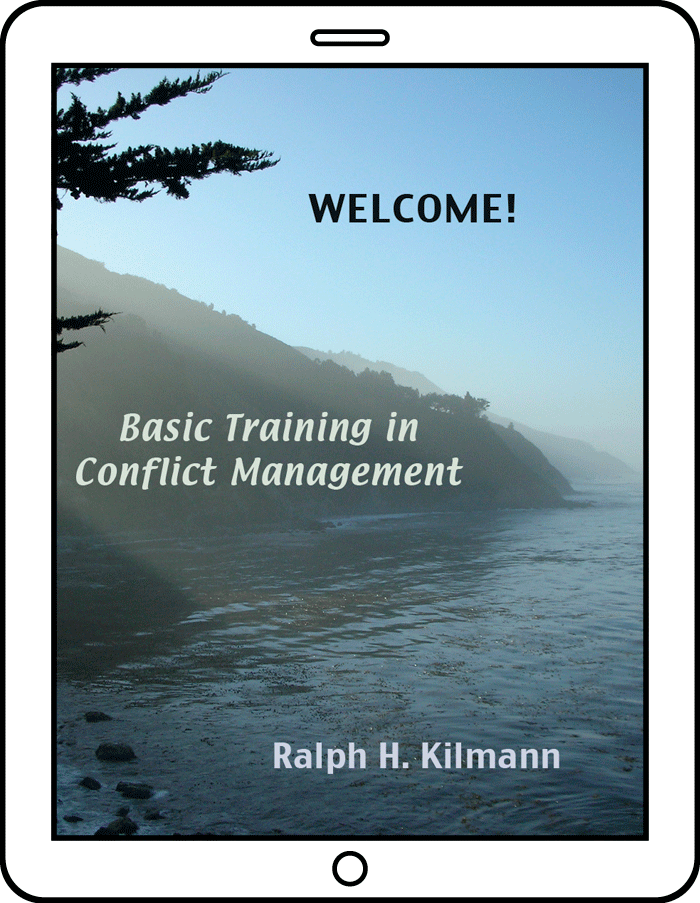 It’s best for group members to take our BASIC Training course if they haven’t had much previous exposure to conflict management and the TKI assessment. But if members have already had considerable experience with discussions on conflict-handling behavior in their group, they can skip BASIC Training and proceed with ADVANCED Training in Conflict Management.
It’s best for group members to take our BASIC Training course if they haven’t had much previous exposure to conflict management and the TKI assessment. But if members have already had considerable experience with discussions on conflict-handling behavior in their group, they can skip BASIC Training and proceed with ADVANCED Training in Conflict Management.
Nevertheless, members should take either BASIC Training or ADVANCED Training before proceeding with GROUP Training in Conflict Management, since they’ll first need to learn how to accurately interpret their “Individual TKI Profiles” before they can meaningfully interpret their more complex “Group TKI Profiles.”
Before beginning the BASIC course, each member should first complete the Thomas-Kilmann Conflict Mode Instrument (TKI) with these modified instructions:
INSIDE your group, how do you usually respond when you find your wishes differing from those of another group member?
When members are about to take the TKI assessment, instruct them to IGNORE the standard TKI instructions that appear on their computer screen or Internet tablet. Instead, they should keep in mind the modified TKI instructions (and the members of their group) as they respond to all 30 A/B items on the assessment.
After all group members have individually reviewed their personalized TKI Report and, on their own, have also watched the entire eighty-minute course while making good use of the Course Manual for Basic Training in Conflict Management, I recommend they discuss the following numbered paragraphs in a sixty-minute meeting:
1.1. As a group, members spend a little time making sure everyone understands the TKI Conflict Model, especially the dimensions of assertiveness and cooperativeness, and the integrative, distributive, and protective dimensions of conflict behavior. Then members share examples of using each of the five conflict modes effectively and suggest whose needs get satisfied in the process. Next, members review the eight key attributes of a conflict situation that determine when each mode is most likely to achieve the most satisfaction for all key stakeholders (internal and external to the organization). Then members discuss the best approach to conflict, given all the principles and practices discussed in BASIC Training in Conflict Management.
1.2. Based on each person’s TKI report, make a tally of how many members scored highest or tied for highest (in the high 25%) on each of the five conflict-handling modes. Also make a tally of how many members scored lowest or tied for lowest (in the low 25%) on each of the five modes. Then plot these results on the TKI Conflict Model on pages 16 and 17 in the manual. Then group members should discuss: Are the identified HIGH or LOW modes actually being used too much or too little? Or are those HIGH and LOW modes actually being used effectively, since these conflict-handling behaviors fit the key attributes of the group’s situation?
1.3. Discuss why approaching workplace problems with a different set of conflict modes (having ALL five modes available to every group member) would likely result in different experiences and outcomes for the group. And how would the organization and its external stakeholders benefit if group members used different modes for their recurring workplace conflicts?
1.4. Develop an action plan to encourage more discernment in using conflict modes more consciously—and purposefully—in the workplace, so as to maximize personal satisfaction and value-added contribution to the work group and the organization. TAKE NOTE: Which variety of conflict modes did members use to develop this action plan—and what were the consequences of using these modes on group performance and member satisfaction?
1.5. How will the work group implement its action plan and then monitor the results for the purpose of ensuring that workplace conflicts are being managed effectively and efficiently? In a subsequent course, ADVANCED Training in Conflict Management, group members will recognize these processes as the steps—and errors—of problem management.
On their own, group members can test their knowledge of the key principles of this course by taking the optional Final Exam for BASIC Training in Conflict Management. Although Kilmann Diagnostics does not award a “certificate of achievement” for this course, receiving a score of 88 or more points (out of 100 possible points on twenty-five, multiple-choice questions) signifies that members have passed the exam and have thus learned the material.
NOTE: The optional Final Exam for every course can be taken as many as five times, since its purpose is to encourage members to learn the material—not to add stress to their life. However, if someone else purchased these courses for the group, the sponsor (for example, the employer) might require group members to pass each exam as an indication that they’ve learned the material. But Kilmann Diagnostics will not share any exam results if a member happens to score less than 88 points on any occasion for any course. We’ll only inform the sponsor when members pass their exams. Click to see Sample Questions on Each Final Exam.
2. GROUP Training in Conflict Management
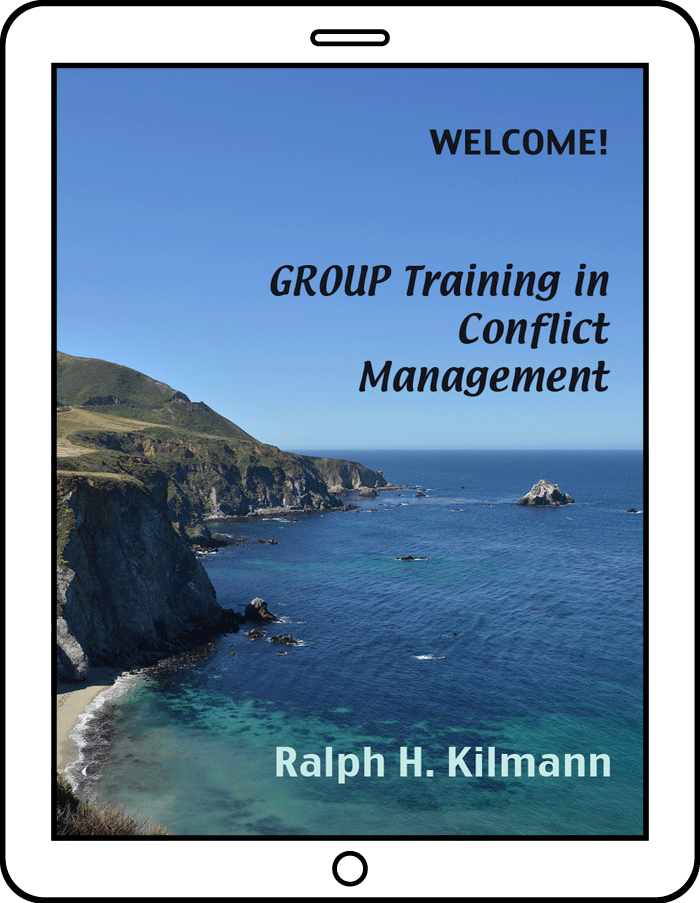 It’s best for group members to first take either BASIC Training or ADVANCED Training before they proceed with GROUP Training, so they’ll have a foundational knowledge of conflict management and how to interpret individual TKI Profiles before learning to interpret the more complex Group TKI Profiles.
It’s best for group members to first take either BASIC Training or ADVANCED Training before they proceed with GROUP Training, so they’ll have a foundational knowledge of conflict management and how to interpret individual TKI Profiles before learning to interpret the more complex Group TKI Profiles.
Conveniently, by having first taken either the BASIC or ADVANCED course, members have already completed the TKI assessment with these modified instructions:
INSIDE your group, how do you usually respond when you find your wishes differing from those of another group member?
For the purpose of developing Group TKI Profiles, however, it’s necessary for members to again take the Thomas-Kilmann Conflict Mode Instrument (TKI), but this time with these modified instructions:
OUTSIDE your group (across all other settings in your life), how do you usually respond when you find your wishes differing from those of another person?
Just before group members take the TKI assessment a second time, remind them to IGNORE the standard TKI instructions that appear on their computer screen or Internet tablet. Instead, they should keep in mind the second modified TKI instructions as they respond to all 30 A/B items on the assessment.
On their own, group members watch the first few video sections, covering pages 1 to 26 in the Course Manual for GROUP Training in Conflict Management. Afterward, the group holds a sixty-minute meeting to discuss these numbered paragraphs:
2.1. Discuss all the distinctions in the Complex Hologram, as they specifically pertain to the topic of this course: The Individual (what each person brings to the group in terms of styles, skills, and conflict-handling modes); The Organization (the formal systems that shape their group’s behavior); CULTURE (the unwritten rules that dictate “how things are done around here”); and The Group (how the members manage their daily stream of problems and conflicts, making use of their individual styles and skills, as shaped by their organization’s strategy-structure, reward system, and those unwritten cultural rules). Members should also discuss how all these interrelated aspects determine whether their organization can effectively respond to The Setting, which ultimately produces The Results.
2.2 Either the group performs a self-diagnosis of the effectiveness of its conflict-handling behavior or an external consultant (a trusted member from the HR department or an outside consultant) performs an independent diagnosis. This “conflict management diagnosis” is conducted through one-on-one interviews with members and/or through a group interview with or without the immediate boss present—based on the prior assessment (see my earlier discussion) on whether the group’s culture would allow for an open and candid dialogue with the boss present. Regardless of how the diagnosis is conducted, however, it’s important to establish whether conflicts among the members are being approached according to the specific guidelines on pages 11 to 18 in the manual. Basically, the diagnosis stipulates if the group is already handling its conflicts in an effective manner or, instead, if significant improvement in conflict management is necessary before members can fully contribute their wisdom and experience to their most important problems and conflicts. Incidentally, this diagnosis will be used in subsequent steps to select specific action recommendations to implement, once the Group TKI Profile has been developed and interpreted.
2.3. Discuss the difference between the standard TKI instructions and the modified TKI instructions, the latter having guided how members responded to the TKI on two different occasions: the initial TKI assessment for INSIDE the group and the second TKI assessment for OUTSIDE the group (across all other settings in a person’s life).
2.4. Discuss the various factors that determine if there are similarities or differences between a member’s INSIDE and OUTSIDE results across those two TKI assessments. Refer back to the Complex Hologram and all those interrelated forces operating on The Group.
2.5. Discuss the special impact the leader or co-leaders have on the group, with regard to how conflicts are addressed and resolved. Does the leader’s behavior have an overwhelming influence (as is the case with the metaphor of the “rectangular table” for an old, large, autocratic organization)? Or does the leader’s behavior join or blend with all the other members in the group (as is the case with the “circular table” for a more egalitarian or quantum organization)? And which arrangement, rectangular or circular, best fits with the types of challenges the group regularly faces—as in simple or complex problems?
On their own, and before they actually tally and discuss their collective results on the two TKI assessments, members watch the next two video sections, Developing Group TKI Profiles and Interpreting Group TKI Profiles, covering pages 27 to 42 in the manual. In a sixty-minute meeting, members develop and then interpret their Group TKI profile by following these steps:
2.6. As a group, using the HIGH and LOW ranges for the five conflict-handling modes on page 27 in the manual, members enter the relevant counts on page 34 for their HIGH and LOW scores, both INSIDE and OUTSIDE their group. At the bottom of that same page, they also enter the number of members who were present for these counts (realizing that this number of group members will not equal the total number of HIGH or LOW scores, since several members may have more than one HIGH or LOW score on their TKI results).
2.7. Once the members have developed their Group TKI Profile, they should assess the “situational similarities” or the “situational differences” that appear across the INSIDE and OUTSIDE perspectives for both HIGH and LOW scores. If there are striking differences between these two perspectives, does this finding help group members understand their challenges in managing conflict? Alternatively, if there are clear similarities, members might consider if their INSIDE versus OUTSIDE settings are truly the same or if members, in fact, have not previously recognized the significant differences in complexity that exist between what is needed for success in their work group versus what conflict-handling behavior is effective in all other settings in their life?
2.8. The members next discuss whether the HIGH or LOW modes INSIDE their group are being overused or underused, respectively, or if the use of these modes represents a good fit with the key attributes in the group’s unique situation.
2.9. The group should then discuss whether the leader’s conflict-handling behavior supports or hinders how members address their daily problems and conflicts. As an aid to this discussion, the group can examine the leader’s HIGH and LOW scores INSIDE and OUTSIDE the group (identified by the numbers on the Group TKI Profile with lighter shades of gray) and see if his or her scores are essentially the same or different from the scores of most other group members. Naturally, if the leader’s approach to managing conflict is much different from the rest of the group, this finding might explain some of the “conflict-handling conflicts” in the group (especially when the boss has undue influence on how members address their complex problems).
2.10. Now the members discuss the impact of The Organization (particularly the reward system) and CULTURE (the unwritten rules) on the group’s use of conflict modes, particularly if there are situational differences between the INSIDE and OUTSIDE perspective.
2.11. The members might also consider if their group has unnecessarily and unconsciously adapted the organization’s culture for their group’s culture, realizing that there can be a difference between the two (as will be discussed subsequently during the Culture Management Course).
On their own, members watch the next two video sections, Troublesome Patterns in Conflict Management and Improving Conflict Management in Your Group, covering pages 43 to 53 in the manual. In a sixty-minute meeting, members then discuss these numbered paragraphs:
2.12. As a group, members discuss the extent to which their Group TKI Profile reflects HIGH on avoiding or accommodating and LOW on competing or collaborating INSIDE the group, while a very different pattern exists OUTSIDE the group. If the Group TKI Profile suggests this most troublesome pattern, members discuss what they can do to overcome this debilitating result, especially if the group is facing increasingly complex problems.
2.13. Now the members further discuss which conflict modes are essential for resolving complex problems versus which modes are sufficient for solving simple problems—and what they can do to ensure they’ll always use the most effective modes to match the complexity of the situation.
2.14. By studying the figure on page 52 in the manual, referred to as the Conflict Management Matrix, members then locate the quadrant that best captures the initial diagnosis of their group’s conflict-handling behavior (effective versus ineffective) as well as the INSIDE/OUTSIDE patterns of their Group TKI Profile (situational similarities versus situational differences). Members should then develop and implement measures to improve conflict management in the group (if the initial diagnosis suggested that improvement was indeed necessary); or members can transfer their conflict-handling wisdom to other settings or diagnose other aspects of their group’s functioning (if the initial diagnosis revealed that the group’s conflict-handling behavior was already effective).
On their own, group members watch the last video section, Congratulations, which is covered on page 54 in the manual. At that time, they can test their knowledge by taking the optional Final Exam for GROUP Training in Conflict Management. Although Kilmann Diagnostics does not award a “certificate of achievement,” receiving a score of 88 or more points signifies that members have passed the exam and have thus learned the key principles of this course.
3. ADVANCED Training in Conflict Management
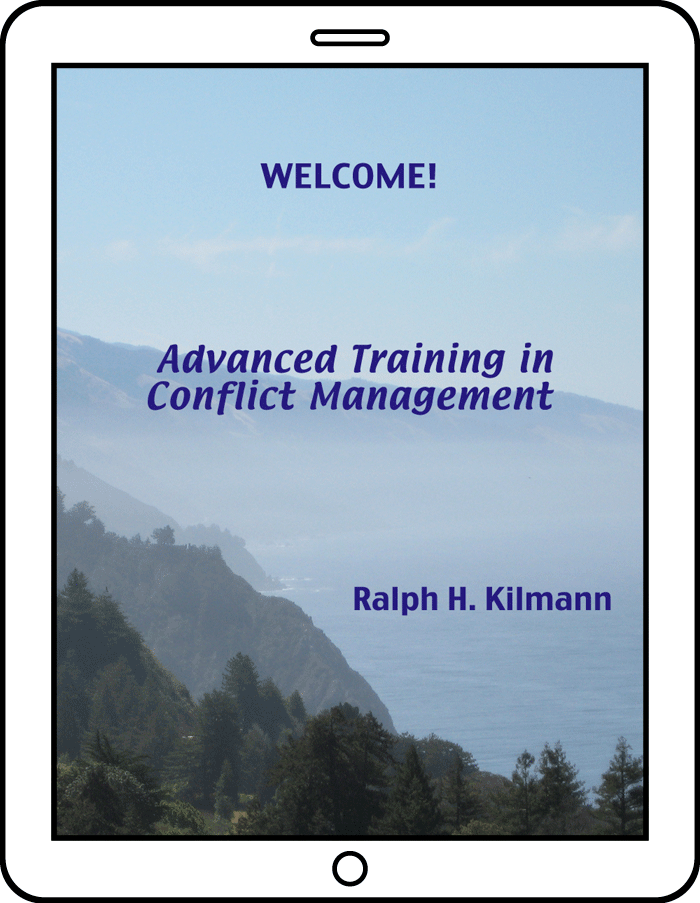 If the work group has already developed considerable wisdom in conflict management, it can bypass BASIC Training and begin with ADVANCED Training in Conflict Management. Once the group learns how to interpret “Individual TKI Profiles,” it should then take GROUP Training, which will explain how to develop and interpret “Group TKI Profiles.” But if the group took BASIC Training, it’s still necessary to proceed with ADVANCED Training, since this higher-level course provides the vital knowledge of psychological type, group process, problem management, and the Problem Management Organization (PMO)—all of which are thoroughly woven into our subsequent courses.
If the work group has already developed considerable wisdom in conflict management, it can bypass BASIC Training and begin with ADVANCED Training in Conflict Management. Once the group learns how to interpret “Individual TKI Profiles,” it should then take GROUP Training, which will explain how to develop and interpret “Group TKI Profiles.” But if the group took BASIC Training, it’s still necessary to proceed with ADVANCED Training, since this higher-level course provides the vital knowledge of psychological type, group process, problem management, and the Problem Management Organization (PMO)—all of which are thoroughly woven into our subsequent courses.
In those cases when the group skipped the BASIC course, however, each member should first complete the Thomas-Kilmann Conflict Mode Instrument (TKI) with these modified instructions:
INSIDE your group, how do you usually respond when you find your wishes differing from those of another group member?
When members are about to take the TKI assessment, instruct them to IGNORE the standard TKI instructions that appear on their computer screen or Internet tablet. Instead, they should keep in mind the modified TKI instructions (and the members of their group) as they respond to all 30 A/B items on the assessment.
Before watching the videos in the ADVANCED course, members should also take the Myers-Briggs Type Indicator (MBTI), if they haven’t taken this assessment in the past few years or if they no longer have access to their personalized report. As a supplement to the MBTI, members might take Kilmanns Personality Style Instrument (KPSI), which measures psychological type specific to work situations (while the MBTI assesses a person’s type across all situations).
After all members have individually reviewed their TKI, MBTI and KPSI results, they separately watch the first few video sections, which covers pages 1 to 37 in the Course Manual for Advanced Training in Conflict Management. In a thirty to sixty-minute meeting (the amount of time will vary whether or not the group skipped the BASIC course), members address this item:
3.1. As a group, members discuss the five numbered paragraphs (1.1 to 1.5) listed under the heading: BASIC TRAINING IN CONFLICT MANAGEMENT. The group’s tally of its high 25% and low 25% conflict modes can be plotted on pages 22 and 23 in the Course Manual for Advanced Training in Conflict Management. NOTE: Even if the group first took BASIC Training, it might still be worthwhile to review what they have previously discussed before moving on to the more complex material in ADVANCED Training.
On their own, group members watch the next video section on Foundations of Psychological Type, which covers pages 38 to 63 in the manual. Afterward, the group meets for about thirty to forty-five minutes to discuss these numbered paragraphs:
3.2. As a group, members spend some time making sure that everyone understands the dimensions of psychological type (extraversion–introversion, sensation–intuition, thinking–feeling, and perceiving–judging) and especially the four middle two combinations: ST, NT, SF, and NF.
3.3. Based on each person’s MBTI (or KPSI) results, make a tally of the variety of psychological types in the work group. Indicate how many ST, NT, SF, and NF types are present, by writing the numbers onto the figure on page 41 in the manual. Knowing this distribution of types will be invaluable for the subsequent online courses as well as for all workplace discussions.
3.4. Make sure that all members examine how their psychological type might compel them to overuse or underuse one or more of the five conflict modes (see page 56 and 57 in the manual). With this knowledge, it will be much easier for group members to compensate for their natural tendency to rely on some modes more or less than others.
On their own, group members watch the video section on Group Process, which is on pages 64 to 80 in the manual. Following, the group spends about thirty minutes discussing these items:
3.5. As a group, members review the ten key principles of group process and the Process Observer (PO) Form (especially pages 77 to 80). Consider how to recognize the specific behaviors that either support or undermine those key principles in workplace meetings.
3.6. Discuss the process by which your group will appoint a Process Observer (PO) for every meeting and how the group will make the best use of the feedback that the PO provides at the end of the meeting (as outlined on page 76). The group should also consider the sequence by which members will take turns serving as the PO during workplace meetings. And the group should discuss what it means if they “forget” to assign a PO and thus fall back on their habitual (typically dysfunctional) group behavior.
On their own, group members watch the video section on Introduction to Problem Management, which is on pages 81 to 103 in the manual. Also on their own, they watch the video section on the Paul Marshall’s Case, which reviews the Work Sheets on pages 103 to 114. But members hit the PAUSE BUTTON soon after the video shows a beautiful clearing in the forest with a single wooden chair. If members haven’t done so already, they next read and study the case itself on pages 104 to 110. Afterward, they individually complete the work sheets on pages 112 to 114. Next, the members reconvene and discuss the following items in a sixty-minute meeting:
3.7. As a group, members review the instructions on page 103 (A Group Discussion on Problem Management), appoint the Process Observer (who makes use of the PO Form on pages 77 to 80), and then plan how the meeting will be conducted. Next, each group member shares the problems that were sensed and how to define them (page 112), what solutions are expected to close the identified gaps (page 113), and how to implement the chosen solutions and evaluate the results (page 114). After the individual sharing has concluded, the group members develop a consensus on their approach to problem management for this case study.
3.8. Toward the end of the group discussion, in five to ten minutes, the PO shares his or her assessment of how well the ten principles of group process were applied during the meeting. The group as a whole then discusses how it will improve its group process the next time it meets.
On their own, group members return to the video and hit the PLAY BUTTON, which was previously paused on the scene of a clearing in the forest with a single wooden chair. As the video begins, the scene switches to a serene path in the forest with a wooden fence on the right side of the path. At this time, I present my analysis of the Paul Marshall’s Case—which will have the most value AFTER the group has already completed and discussed the Work Sheets on Using Problem Management.
3.9. As a group, members list the similarities and differences between its analysis and my analysis of the case study. The group then summaries what it learned through this comparison (taking special note of any gaps) and then agrees on how to approach its workplace problems with these same principles and practices.
On their own, members watch the next two video sections, The Nature of Problems and The Problem Management Organization (PMO), which appear on pages 115 to 131 in the manual. Next, in a thirty-minute meeting, they discuss these items:
3.10. As a group, members review the process by which a PMO minimizes the most damaging errors in problem management for the most complex problems and conflicts facing an organization. Why is it so important to first magnify differences across the C-Groups before resolving those differences within an S-Group? Members then outline the key principles for designing and using a PMO, so this “collateral organization” has the best chance to succeed with all five steps of problem management.
3.11. How can these PMO principles and practices be applied in one work group of just three to ten members (or whatever happens to be the size of the current group)? Members then list some recurring workplace problems that would benefit from making use of these PMO principles and practices.
3.12. How will the work group implement some version of the first three tracks in order to make sure that it has a healthy behavioral (or quantum) infrastructure for problem management—and a PMO?
3.13. Did the group remember to assign a PO and plan the process BEFORE it proceeded with the content of this meeting? Did members remember to allocate a few minutes toward the end of the meeting to receive and discuss the PO’s feedback? If the answer is “no” to either question, members should discuss why they “forgot” to use this necessary method for improving group process.
On their own, group members can take the optional Final Exam for Advanced Training in Conflict Management, as described on page 132 of the manual and explained on the last video section of the course: Graduation. Upon successful completion of the Final Exam (receiving at least 88 out of 100 total points), each member receives the Certificate for Advanced Training in Conflict Management. Obtaining this certificate signifies that the person has learned the key principles of the course—and is now ready to apply them in the workplace.



